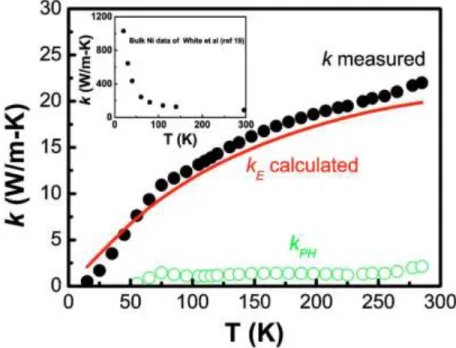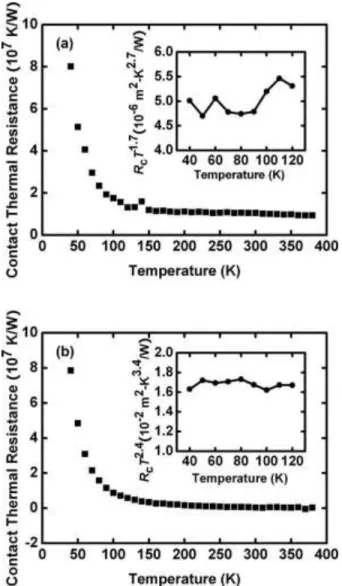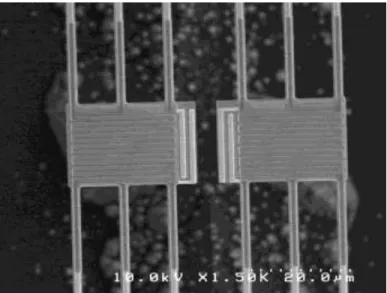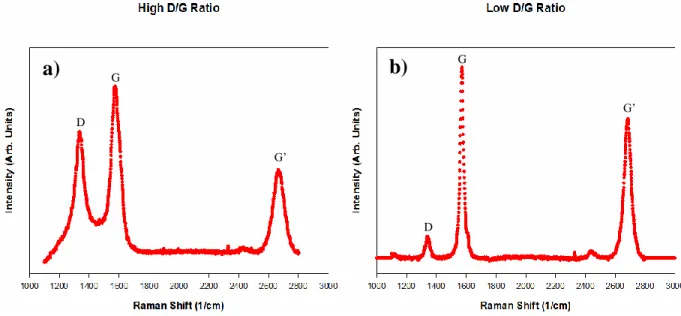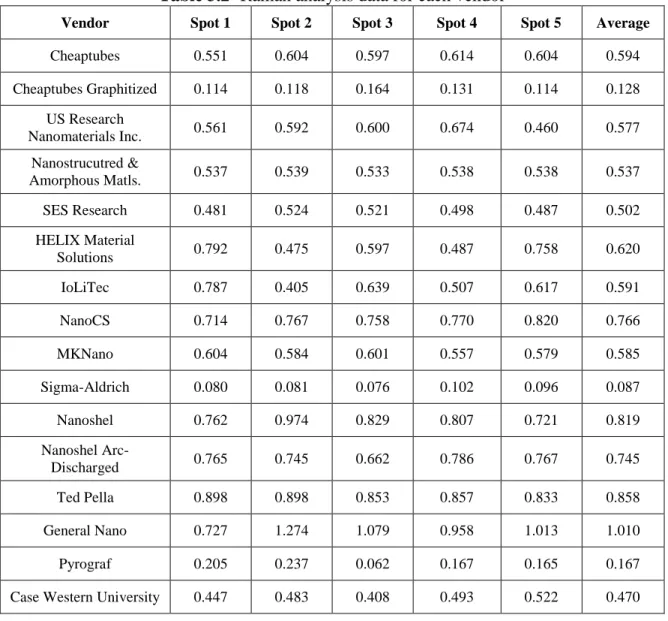13 Figure 1.5 - The measured total contact thermal resistance as a function of temperature of a) the cross contact; and b) the aligned contact. 51 Figure 4.2- Measured total thermal conductivity and nominal thermal conductivity of the sample with two ~80 nm diameter gold nanowires forming a cross contact. 54 Figure 4.5- Measured total thermal conductivity and derived nominal thermal conductivity of the sample with two ~98 nm diameter gold nanowires forming a cross contact.
56 Figure 4.7- a) Measured thermal conductivity and b) the extracted effective and intrinsic thermal conductivity of the gold nanowire with a diameter of ~107 nm.
Phonon Transport in Carbon Nanotubes
Fujii 2005) measured the thermal conductivity of a single suspended CNT using a T-type nanosensor attached to the sample. Experimental results showed that the thermal conductivity of CNT increases with the decrease of its diameter. The results also showed that the thermal conductivity can reach about 2070 W/m-K for CNTs with a diameter of 9.8 nm.
Therefore, the indicated thermal conductivity is usually lower than the intrinsic thermal conductivity of CNTs.
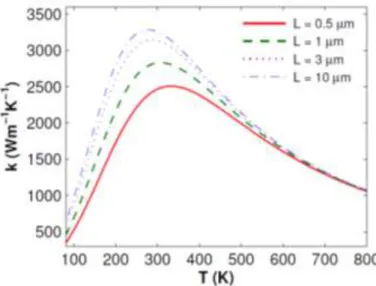
Thermal Transport in Metallic Nanostructures
Lu, 2002) concluded that the thermal conductivity of a gold nanowire is directly proportional to its size. Bulk metal thermal conductivity follows the Wiedemann-Franz law which states that the ratio of the electronic contribution of the thermal conductivity (κ) to the electrical conductivity (σ) of a metal is proportional to temperature (T) as:. The higher value for the thermal conductivity due to electrons at low temperatures indicates a violation of the Wiedemann-Franz law at these temperatures.
This thesis attempts to compare the thermal conductivity of gold nanowires with those reported in the literature.
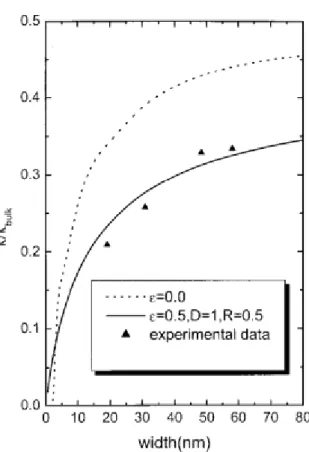
Contact thermal resistance
He is also trying to analyze the thermal resistance of the point junction in crossed gold nanowires. In the presence of a heat flux J (W/m2) across the boundary, the boundary thermal resistance creates a temperature discontinuity ΔT at the boundary. The authors measured the contact thermal resistance between two individual MWCNTs forming different contact morphologies.
Yang, 2010) of determining the contact thermal resistance between two nanostructures is used in the thesis.
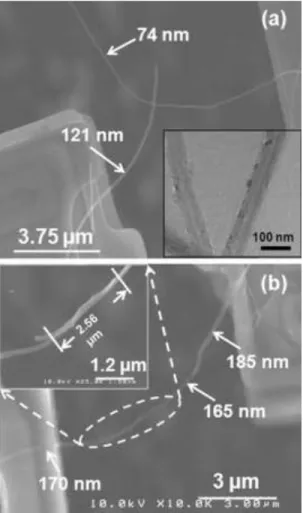
Summary
From these two measurements, the intrinsic thermal conductivity of MWCNT can be deduced (Yang, 2011). Yang, 2011), as briefly described in Chapter 2, the internal thermal conductivity of the sample is derived. a) b). In addition, the thermal resistance of the nanowires can be properly subtracted from the measured total thermal resistance.
In MWCNT measurements from Case Western University, the contact thermal resistance was about 55-65%.
MEASUREMENT SETUP
Device Design
Each device consists of two adjacent 18.2 µm x 27.1 µm low voltage silicon nitride (SiNx) membranes, which are suspended using six 0.5 µm thick, 416 µm long and 2.2 µm wide SiNx beams. Each membrane houses a platinum resistance thermometer (PRT) composed of 30 nm thick and 500 nm wide platinum lines arranged in a serpentine pattern. The PRT is connected via 1.2 µm wide platinum leads on each SiNx beam to 400 µm x 500 µm platinum contact pads placed on the substrate.
Sample Preparation
The device has very fine adjustment screws in three dimensions that can be used to guide the tip to precise locations and capture a nanostructure via the van der Waals force without damaging it. Another advantage of casting the nanostructures on PDMS is that PDMS is a rubber-like substance that will deflect under pressure from the manipulator tip, meaning the tip is not damaged each time a nanostructure is picked up.
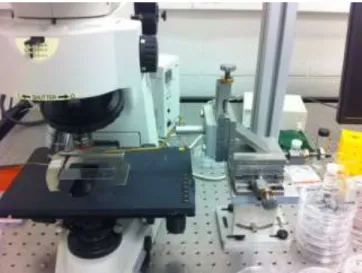
Measurement Setup
Yang, 2011), the internal thermal conductivity of a single nanostructure and its contact thermal resistance with a heat source/sink can be extracted by multiple measurements of the same sample. RCNT/L is the intrinsic thermal resistance of the nanostructure per unit length, and LM is the suspended length of the sample between the two membranes. The large diameter of the sample in addition to the short contact length of the tube on each membrane could cause the contact thermal resistance between the tube and the membranes to significantly change the derived thermal conductivity.
The low thermal conductivity is most likely derived from the irregular diameter and weak structure of MWCNT. Between measurements, the sample was manipulated to give a different suspension length between the membranes of the microdevice. These measurements will then be compared to the measurement of a single gold nanowire to determine the thermal resistance of the dot contact.
Similarly, Rwire2/L is the thermal resistance of wire 2 per unit length, and L2 is the suspended length of wire 2 from the contact point to the edge of the suspended membrane. Both nanowires are ∼80 nm in diameter, and the total length of the heat transfer path between the two suspended membranes is about 7.5 μm. We hoped that this would allow us to determine the intrinsic thermal resistance of the nanowire, although the thermal contact resistance dominates the thermal measurement.
This means that the percentage of the thermal resistance due to contacts with each membrane is relatively small compared to the intrinsic thermal resistance of the tube. 34;Measurement of the thermal conductivity of individual carbon nanotubes by the four-point-three-omega method." Nano Letters.
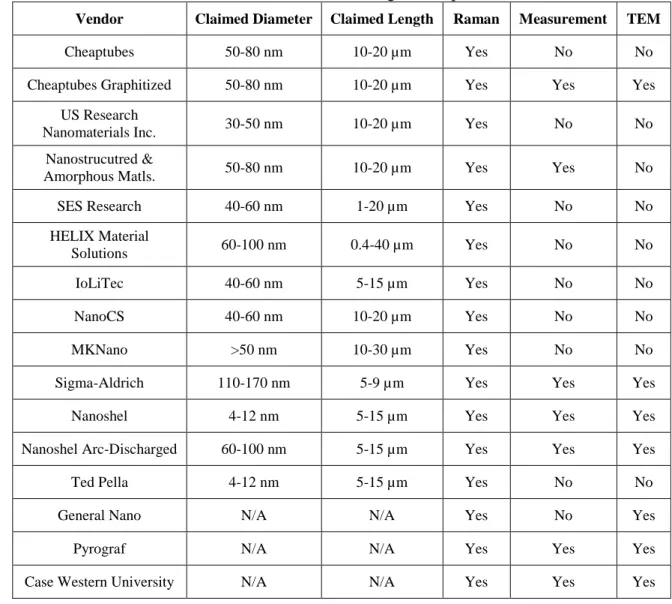
THERMAL CONDUCTIVITY OF MULTI-WALLED CARBON NANOTUBES
Samples for TEM Study Only
A TEM study showed poor structure, so it was decided that thermal conductivity measurements were not necessary. It is easy to see that the carbon layers are not well arranged and in fact it is difficult to make out the clear structure of the tube. Wall thickness cannot be determined from TEM analysis, nor can the thickness of the amorphous layer be calculated.
From the TEM images, it was decided that a thermal measurement was not necessary because the thermal conductivity is expected to be low based on the low quality of the tube structure.
Samples with Low Thermal Conductivities
- MWCNTs from Sigma Aldrich
- MWCNTs from Nanoshel
- Nanoshel Arc Discharged
This sample did not have a long contact length with each membrane, so the contact thermal resistance on each membrane may play an important role in the measured thermal conductivity, especially given the large diameter of the sample. The thermal conductivities of the Pyrograf sample, graphitized Cheaptubes sample, NanoAmor sample, and both Case Western sample measurements and the calculated intrinsic thermal conductivities are shown in Figure 3.17. This indicates that the contact thermal resistance on each membrane contributed to the thermal conductivity results.
By subtracting the measured total thermal resistance from both measurements, the intrinsic thermal conductivity was derived. The total contact length between the gold nanowires and suspended membranes is 10.4 µm, with 6.1 µm of this contact on the right side and 4.3 µm on the left side. The same procedure as used to find the intrinsic thermal conductivity of MWCNTs from Case.
Interestingly, one measurement indicated a surprisingly high nominal thermal conductivity even with the effects of all thermal contact resistance.

Samples with High Thermal Conductivities
- MWCNTs from Pyrograf
- Cheaptubes Graphitized
- MWCNTs from Nanostructured & Amorphous Materials
- MWCNTs from the Case Western University
THERMAL TRANSPORT THROUGH GOLD NANOWIRES AND THEIR
Gold Nanowire Contact Thermal Resistance
We decided to measure the thermal resistance of a point contact between two gold nanowires, which are placed on a measuring microdevice in a crossed configuration. First, the contact thermal resistance between the wires and the membrane must be approximately the same for different measurements. However, for gold nanowires, the contact thermal resistance appears to be much smaller because if the contact thermal resistance is as significant as that of MWCNTs, the thermal conductivity of gold nanowires would be greater than that of bulk gold, which is impossible.
With this, if we can assume that the thermal contact resistances in each membrane are equal in different measurements, then we can find the thermal resistance at the point of contact between the two gold nanowires. For the measurement scheme to be valid, the thermal contact resistance between the nanowire and the two suspended membranes must be approximately the same in different measurements. As a result, the contact thermal resistance differs in these two measurements, which leads to unreasonable results of a lower than effective internal thermal conductivity.
Yang, 2011) to try to calculate the contact thermal resistance per unit length between the nanowire and the membranes. However, if the nanowire has a much longer contact length on one membrane, the contact thermal resistance between the nanowire and the membrane with the shorter contact will dominate. Since the internal thermal resistance of the nanowires is about ⁄ and the contact thermal resistance is about ⁄, smaller diameter wires and/or longer wires that can be completely thermized by the membranes are needed for a successful measurement.
It appears that for the gold nanowire measurements performed and reported in this thesis, the thermal contact resistance accounts for a very large percentage of the thermal contact resistance. We wanted to extract the thermal resistance of a point contact between two gold nanowires.
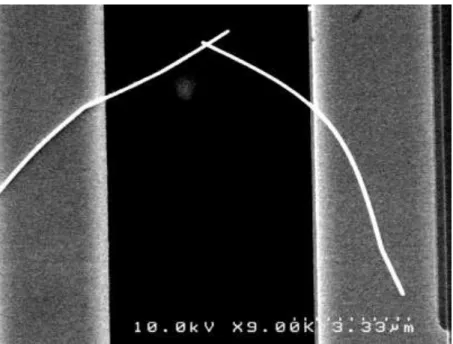
CONCLUSIONS
Multi-walled Carbon Nanotubes
From most of our thermal conductivity measurements, we find that most CVD MWCNTs available in bulk are of relatively low quality. However, the highest thermal conductivity we obtained is only 257.35 W/m-K from a sample produced by Case Western University. It should be noted that these low values are the effective thermal conductivity, including the effects of contact thermal resistance in the measurements.
However, we estimate that removing the contact thermal resistance will only lead to a thermal conductivity of a few hundreds of W/m-K, which is still far below the required very high thermal conductivity for MWCNTs. This study strongly suggests that in engineering practice, such as the use of CNTs to improve the thermal conductivity of CNT-based composites, it cannot be blind. In the future, it may be useful to study smaller MWCNTs and MWCNTs produced by different methods, including more samples produced by the arc discharge method.
Gold Nanowires
This is because the thermal properties of MWCNTs are highly dependent on their physical structure, and our Raman spectroscopy examination and TEM characterization show that many bonding and structural defects exist in these MWCNTs. A hot-wire probe for thermal measurements of nanowires and nanotubes inside a transmission electron microscope. Review of Insturents Scientific 78: 104903. Raman characterization of linear carbon nanotubes produced by vapor thermal decomposition of hydrocarbons. Applied Physics Letters 70: 2684.
